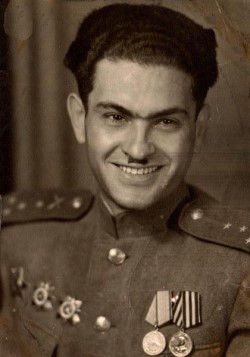Leon Tipograf was born in 1919 in Odessa. In 1937 he completed a course for the maintenance of textile machinery and then worked at an Odessa textile factory. In 1939 he was drafted into the Red Army and sent to a naval school. Later he served with an artillery unit at the naval base in Sevastopol on the Black Sea. After the Germans occupied the Crimea, he was sent to an officers' course, which he finished as a lieutenant. He was then attached to the 69th Army as the commander of an anti-aircraft platoon and saw action in the North Caucasus.
In June 1942, during battles in eastern Ukraine, Tipograf was seriously wounded and taken prisoner. In a German field hospital for POWs he claimed that he was a Muslim Adjarian from the town of Makhinjauri (in the Southern Caucasus), where he had lived in 1931 and 1932. The fact that he knew the local dialect helped support his claim. As a supposed Muslim, Tipograf witnessed the implementation of "the final solution" in the POW camp. The Germans assembled all the POWs who had been identified as Jewish, brutally abused them, and then shot them to death. Tipograf managed to escape from the POW camp and wandered through eastern Ukraine and the North Caucasus, trying to make his way to the front lines. According to his memoirs, local citizens recognized him as a Soviet soldier who had escaped from a POW camp and often asked whether he was Jewish.
After six months in the enemy rear, Tipograf crossed the front line and met up with Soviet military units. He was immediately taken for interrogation by SMERSH intelligence agents. After the three days, the SMERSH agents concluded that Tipograf was not an enemy spy and that his behavior in the occupied territories had demonstrated that he was "loyal to the Soviet regime." Thereupon, Tipograf again became the commander of an anti-aircraft platoon, this time of the 534th Regiment. Fighting while advancing westward with this regiment, he reached Germany, where he saw witnessed the end of the war.
In the summer of 1943, while advancing through the Northern Caucasus, Tipograf passed through one of the villages where he had stayed a long time on his way toward the front line a year earlier. The locals were astonished when they recognized their soldier, now in an officer's uniform, speaking Russian without a Caucasian accent, and – most surprising of all – openly Jewish. A local lad told him: "You did good that concealed your nationality [ethnicity]. I would have denounced you." Tipograf asked: "Why?" – only to hear the answer: "I don't know why; but I would have done so."
In Volhynia (Western Ukraine) in 1944 Tipograf and his soldiers took part in the exhumation of a mass grave of Jews who had been killed by the Nazis in 1941 or 1942. Later he was shocked when he saw Majdanek, which had been liberated by the Red Army only a short time before.
In January 1945 Tipograf took part in the liberation of Poznań, Poland. The city had been burned and largely destroyed. In an attempt to raise the morale of the now homeless local Poles, the Red Army men served them a meal (naturally accompanied with vodka), distributed to them clothes captured from the Germans, and a Russian officer played on the accordion "Marsz Dąbrowski", the national anthem of Poland. The Poles were moved to tears, with one of them saying: ""The Germans shot us for the national anthem, but now the Soviets have come and played our anthem. We have not seen anything good from the Germans. The only good thing they did was that they killed all the Yids." Tipograf responded that he himself was a "Yid" and that the things that the Germans did to the Jews were the worst of all their deeds.
Tipograf received a number of military awards, including two orders of the Patriotic War and the Order of the Red Star. After the war, he settled in Lviv (Lwów), Western Ukraine.
In the 1990s he left the USSR and immigrated to Israel.







